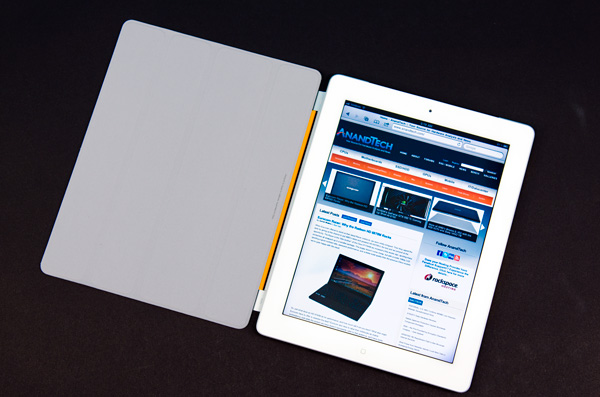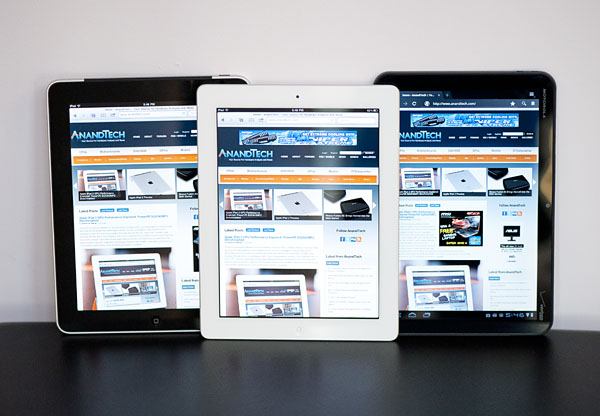The Apple iPad 2 Review
by Brian Klug, Anand Lal Shimpi & Vivek Gowri on March 19, 2011 8:01 PM ESTFinal Words
If you fell in love with the original iPad, the iPad 2 is a significant upgrade. You get much faster hardware, a much more ergonomic device and the ability to FaceTime with your friends. If it weren't for the fact that the iPad 3 is likely 12 months away with another set of similarly impressive upgrades I'd recommend all iPad users upgrade to the 2nd generation model.
I find that with Apple products you have to pick an upgrade cadence and firmly stick to it. In the Mac world it's difficult but not too hard to stick to. Upgrading yearly never makes financial sense so usually putting yourself on a 2 - 3 year cycle for the biggest upgraders usually works. Apple hardware tends to hold its value surprising well so as long as you do a good job of reselling your old stuff, this cadence can work well if you absolutely must have the latest and greatest.
The iOS platforms are a bit more difficult to be patient with. As you can see by the SoC upgrades Apple has thrown into the iPad 2, for the next couple of years you should expect Apple to be upgrading at a rate faster than Moore's Law. Eventually this will level off but for the iPad 2, iPad 3 and probably even the iPad 4 we'll see this sort of aggressive ramp in hardware capabilities. You really have to treat the iPad like a smartphone - it's going to be made significantly less desirable in about 12 months so plan your purchasing accordingly.
Cautious purchasing brings me to my biggest complaint about the iPad 2 - its pricing. Motorola gets a bad rap for pricing the first Xoom at $799, but there's only one iPad 2 that sells at $499. Buy a case, pick one of the higher capacity models, add 3G and you're quickly paying a lot more for the iPad 2 than you would a mainstream PC. Granted Apple doesn't make as much off of the iPad as it does other members of its product lineup, but I still feel the price is too much for a device that can only augment your existing computing devices.
I do wish Apple was able to increase display resolution on the iPad 2, although I suspect that combined with the SoC improvements that may have been a little too much for this generation. It's clear that a higher resolution panel is coming as Apple finally has an OS that properly handles DPI scaling. The real question is when, and is that time soon enough that you can hold off buying an iPad until then?
There's no better place to say this so I'll just put it out there: Apple's commitment to increasing performance deserves serious recognition. Whether or not you like the company, Apple outfitted the iPad 2 with a pair of ARM Cortex A9s and a GPU significantly faster than anything else on the market. Look around and you won't see many apps that can really stress the PowerVR SGX 543MP2 that Apple put in the A5. Make no mistake, this is about building a big install base of high performance mobile devices. Apple is eager to win the hearts of game developers with the A5. Gaming will be an important part of the tablet's evolution and Apple clearly understands that. What happens when your tablet is fast enough to run Halo? Performance matters here, maybe not as much today, but when the entire install base has PowerVR SGX 543MP2s at the bare minimum things will get really interesting.
Apple's fat trimming really improved the iPad 2's ergonomics, and the smart covers only helped improve things. While I wouldn't consider porting the original iPad around due to its limited usefulness in my workflow, the iPad 2 is thin and light enough where I'm less bothered by it. Ultimately I feel like tablets (iPad or not) have to be even thinner and even more ergonomic to really come into their own. The good news is that Apple hasn't done anything too exotic in slimming down the original iPad. I'd expect the second generation of Android tablets to be similarly thin/light.
And that brings us to the controversy, the Honeycomb comparison. The Xoom is the only real competition shipping for the iPad 2 today, but within 60 days we'll likely have competitors from ASUS and Samsung on the market as well. Honeycomb has some serious advantages in the feature department. Multitasking is better under Android 3.0, as are notifications and as of yesterday there's finally Flash support. Apple still provides a smoother UI than Honeycomb, however this time around I'm wondering how much of that might be due to the GPU horsepower behind Tegra 2. While Tegra 2 does well on a lower resolution screen, I feel like it is underpowered to deal with the Xoom's 1280 x 800 display.
Hardware-wise Apple has an ergonomics advantage over the Xoom. While I like holding the Xoom more than the original iPad, I prefer the iPad 2's feel to the Xoom. The Xoom has the edge in camera quality and display resolution, while the iPad 2 has a better looking display and a faster GPU. I still fundamentally believe that web browsing and email are the killer apps for tablets and as such I don't put too much weight in Apple's iPad app advantage. Long term I believe that the most important apps will be available on both platforms, so unless there's an app that you want today that's an iOS exclusive I wouldn't lose sleep over it.
So if you're actually torn between the iPad 2 and the Xoom my best advice is to wait. Apple needs to update iOS in a major way and Honeycomb needs a hardware update. Whichever gets it right first should get your money.
If you don't fall into the borderline camp then the decision is pretty simple. If you need a tablet that runs iOS today, the iPad 2 is great. If you're not sure, you should wait. Tablets are still a couple of generations from being really amazing. Everything between now and then are just steps along the way.














189 Comments
View All Comments
PeteH - Saturday, March 19, 2011 - link
In the Garage Band section:"There are three Smart Instruments - Piano, Bass, Guitar, and Drums."
I'm pretty sure that "three" should be a "four."
VivekGowri - Sunday, March 20, 2011 - link
Ahaha, I'm an idiot - thanks for catching that, it'll be fixed.PeteH - Sunday, March 20, 2011 - link
As far as typos go that one isn't remotely bad. I once published a spec (internally) that had a section detailing how asynchronous boundaries were handled in my section of a chip. Unfortunately I had titled that section "Cock Domain Crossings."Anand Lal Shimpi - Sunday, March 20, 2011 - link
A few years ago I used the word overcocking instead of overclocking in an article.UNLK A6 - Saturday, March 19, 2011 - link
I'd like some clarification about LINPACK and Geekbench. Are these benchmarks created by compiling some portable code for each platform as a measure of floating point performance? Or, is this supposed to be some measure of how fast one can do linear algebra or DSP on the platform? On Mac OS and iOS, one wouldn't compile say LINPACK for this but use the hand-tuned LAPACK/BLAS and DSP routines built into Apple's Accelerate Framework. The difference between the two can be huge. Which do these benchmarks purport to supply--generic floating point performance or available linear algebra and DSP performance on the platform?metafor - Sunday, March 20, 2011 - link
I believe Linpack on both iOS and Android are plainly compiled (by the JIT in the case of Android) to run on the platform. They don't make any calls against the onboard DSP's nor do they use NEON beyond what the compiler is able to auto-vectorize.name99 - Sunday, March 20, 2011 - link
Apple supplies all the Linpack routines in optimized NEON code as part of the OS (in the Accelerate framework). Intelligent apps that need them use those routines.Android, as far as I know, does not provide an equivalent.
You can use apps that deliberately bypass these iOS routines if you wish to get a handle on the raw FP performance of the hardware, but
(a) it doesn't give actual linear algebra performance, if that is something your app or algorithm really cares about AND
(b) it's kinda dumb because if you care about fp performance in any way, you'll be using NEON, so what's the value in a benchmark that doesn't exercise NEON?
nimus - Sunday, March 20, 2011 - link
I hope AnandTech can do a comprehensive comparison of the usability/feature strengths between the Android, Apple iOS, BlackBerry Tablet OS (QNX), HP webOS, and any others tablet OSes.It will be interesting to see how the Windows Tablet OS will be able to compete when it finally is released for ARM processors.
KidneyBean - Sunday, March 20, 2011 - link
I'm using a tablet, so I can't see the mouse-over pics :-(tcool93 - Sunday, March 20, 2011 - link
I don't know where the reviewer gets the idea Netbooks are much faster. That is nonsense. Here is a video showing an ARM 9 processor being just as fast, yet the ARM 9 processor is running 1/3 the speed of the Netbook Atom. (500mhz vs. 1600mhz for the Netbook).http://www.youtube.com/watch?v=W4W6lVQl3QA&fea...
The Netbook also has a graphics accelerator in it, and the ARM shown in this video doesn't.